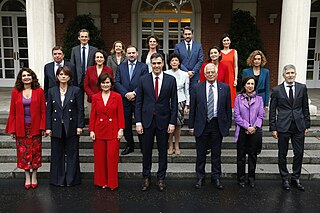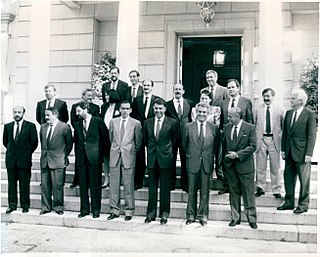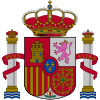
The Ministry of Culture and Sport (MCD) is the department of the Government of Spain responsible for the promotion, protection and dissemination of the Spanish historical heritage, national museums, art, books, reading and literary creation, of cinematographic and audiovisual activities and of national archives and libraries.

The Ministry of Economic Affairs and Digital Transformation (MINECO) is the department of the Government of Spain responsible for the proposing and carrying out the government policy on economic affairs, business support and reforms to improve economic potential growth as well as acting as the communication channel with the European Union and other economic and financial international organizations in this matters. Likewise, this department is responsible for the telecommunications policy and the digital transformation.

The government of Leopoldo Calvo-Sotelo was formed on 27 February 1981, following the latter's election as Prime Minister of Spain by the Congress of Deputies on 25 February and his swearing-in on 26 February, as a result of Adolfo Suárez's resignation from the post on 29 January 1981. It succeeded the third Suárez government and was the Government of Spain from 27 February 1981 to 3 December 1982, a total of 644 days, or 1 year, 9 months and 6 days.

The first government of Pedro Sánchez was formed on 7 June 2018, following the latter's election as Prime Minister of Spain by the Congress of Deputies on 1 June and his swearing-in on 2 June, as a result of the success of a motion of no confidence against Mariano Rajoy. It succeeded the second Rajoy government and was the Government of Spain from 7 June 2018 to 13 January 2020, a total of 585 days, or 1 year, 7 months and 6 days.

The Ministry of Science and Innovation (MICINN) is the department of the Government of Spain responsible for developing and implementing the government policy on scientific research, technological development and innovation in all sectors. In particular, MICINN is responsible for the exercise of research, technological development and innovation competencies in space matters, including representation and participation in European Union and International organizations.

The government of Uxue Barkos was formed on 23 July 2015, following the latter's election as President of the Government of Navarre by the Parliament of Navarre on 20 July and her swearing-in on 22 July, as a result of Geroa Bai (GBai) being able to muster a majority of seats in the Parliament together with EH Bildu and Izquierda-Ezkerra (I–E), with external support from Podemos, following the 2015 Navarrese regional election. It succeeded the Barcina government and was the Government of Navarre from 23 July 2015 to 7 August 2019, a total of 1,476 days, or 4 years and 15 days.

The first government of José Luis Rodríguez Zapatero was formed on 18 April 2004, following the latter's election as Prime Minister of Spain by the Congress of Deputies on 16 April and his swearing-in on 17 April, as a result of the Spanish Socialist Workers' Party (PSOE) emerging as the largest parliamentary force at the 2004 Spanish general election. It succeeded the second Aznar government and was the Government of Spain from 18 April 2004 to 14 April 2008, a total of 1,457 days, or 3 years, 11 months and 27 days.

The second government of José Luis Rodríguez Zapatero was formed on 14 April 2008, following the latter's election as Prime Minister of Spain by the Congress of Deputies on 11 April and his swearing-in on 12 April, as a result of the Spanish Socialist Workers' Party (PSOE) emerging as the largest parliamentary force at the 2008 Spanish general election. It succeeded the first Zapatero government and was the Government of Spain from 14 April 2008 to 22 December 2011, a total of 1,347 days, or 3 years, 8 months and 8 days.

The first government of Mariano Rajoy was formed on 22 December 2011, following the latter's election as Prime Minister of Spain by the Congress of Deputies on 20 December and his swearing-in on 21 December, as a result of the People's Party (PP) emerging as the largest parliamentary force at the 2011 Spanish general election. It succeeded the second Zapatero government and was the Government of Spain from 22 December 2011 to 4 November 2016, a total of 1,779 days, or 4 years, 10 months and 13 days.

The second government of Mariano Rajoy was formed on 4 November 2016, following the latter's election as Prime Minister of Spain by the Congress of Deputies on 29 October and his swearing-in on 31 October, as a result of the People's Party (PP) emerging as the largest parliamentary force at the 2016 Spanish general election. It succeeded the first Rajoy government and was the Government of Spain from 4 November 2016 to 7 June 2018, a total of 580 days, or 1 year, 7 months and 3 days.

The first government of José María Aznar was formed on 6 May 1996, following the latter's election as Prime Minister of Spain by the Congress of Deputies on 4 May and his swearing-in on 5 May, as a result of the People's Party (PP) emerging as the largest parliamentary force at the 1996 Spanish general election. It succeeded the fourth González government and was the Government of Spain from 6 May 1996 to 28 April 2000, a total of 1,453 days, or 3 years, 11 months and 22 days.

The second government of José María Aznar was formed on 28 April 2000, following the latter's election as Prime Minister of Spain by the Congress of Deputies on 26 April and his swearing-in on 27 April, as a result of the People's Party (PP) emerging as the largest parliamentary force at the 2000 Spanish general election. It succeeded the first Aznar government and was the Government of Spain from 28 April 2000 to 18 April 2004, a total of 1,451 days, or 3 years, 11 months and 21 days.

The first government of Felipe González was formed on 3 December 1982, following the latter's election as Prime Minister of Spain by the Congress of Deputies on 1 December and his swearing-in on 2 December, as a result of the Spanish Socialist Workers' Party (PSOE) emerging as the largest parliamentary force at the 1982 Spanish general election. It succeeded the Calvo-Sotelo government and was the Government of Spain from 3 December 1982 to 26 July 1986, a total of 1,331 days, or 3 years, 7 months and 23 days.

The second government of Felipe González was formed on 26 July 1986, following the latter's election as Prime Minister of Spain by the Congress of Deputies on 23 July and his swearing-in on 24 July, as a result of the Spanish Socialist Workers' Party (PSOE) emerging as the largest parliamentary force at the 1986 Spanish general election. It succeeded the first González government and was the Government of Spain from 26 July 1986 to 7 December 1989, a total of 1,230 days, or 3 years, 4 months and 11 days.

The third government of Felipe González was formed on 7 December 1989, following the latter's election as Prime Minister of Spain by the Congress of Deputies on 5 December and his swearing-in on 6 December, as a result of the Spanish Socialist Workers' Party (PSOE) emerging as the largest parliamentary force at the 1989 Spanish general election. It succeeded the second González government and was the Government of Spain from 7 December 1989 to 14 July 1993, a total of 1,315 days, or 3 years, 7 months and 7 days.

The fourth government of Felipe González was formed on 14 July 1993, following the latter's election as Prime Minister of Spain by the Congress of Deputies on 9 July and his swearing-in on 13 July, as a result of the Spanish Socialist Workers' Party (PSOE) emerging as the largest parliamentary force at the 1993 Spanish general election. It succeeded the third González government and was the Government of Spain from 14 July 1993 to 6 May 1996, a total of 1,027 days, or 2 years, 9 months and 22 days.

The second government of Pedro Sánchez was formed on 13 January 2020, following the latter's election as Prime Minister of Spain by the Congress of Deputies on 7 January and his swearing-in on 8 January, as a result of the Spanish Socialist Workers' Party (PSOE) emerging as the largest parliamentary force at the November 2019 general election. It succeeded the first Sánchez government and is the incumbent Government of Spain since 13 January 2020, a total of 1,277 days, or 3 years and 6 months.

The seventh government of Francisco Franco was formed on 8 July 1965. It succeeded the sixth Franco government and was the Government of Spain from 8 July 1965 to 30 October 1969, a total of 1,575 days, or 4 years, 3 months and 22 days.

The Third Urkullu Government is the incumbent regional government of the Basque Country led by President (Lehendakari) Iñigo Urkullu. It was formed in September 2020 after the regional election.

The Instituto de Turismo de España – Turespaña, is the official agency of the Government of Spain responsible for the marketing of the country as a tourist destination throughout the world. It depends on the Ministry of Industry, Trade and Tourism through the Secretary of State for Tourism.


























